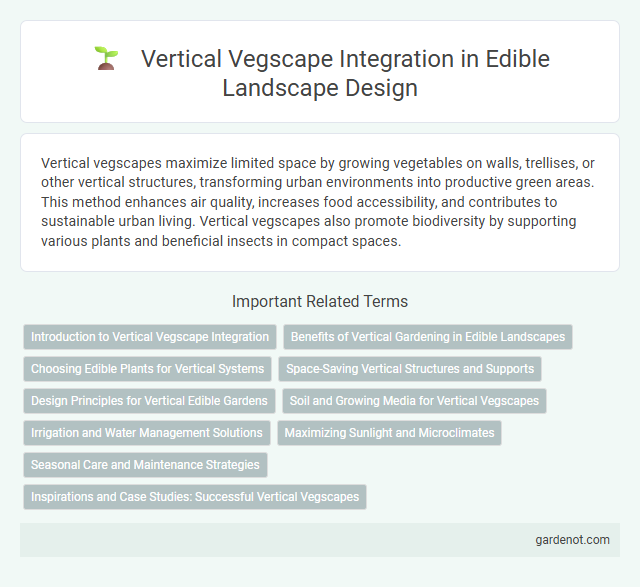Vertical vegscapes maximize limited space by growing vegetables on walls, trellises, or other vertical structures, transforming urban environments into productive green areas. This method enhances air quality, increases food accessibility, and contributes to sustainable urban living. Vertical vegscapes also promote biodiversity by supporting various plants and beneficial insects in compact spaces.
Introduction to Vertical Vegscape Integration
Vertical vegscape integration transforms limited urban spaces into thriving edible landscapes by utilizing vertical structures such as trellises, walls, and towers to grow vegetables. This innovative approach maximizes productivity by enhancing sunlight exposure and improving air circulation for crops like tomatoes, beans, and leafy greens. Effective integration involves selecting suitable plant species, implementing efficient irrigation systems, and leveraging modular designs to optimize growth and aesthetics in constrained environments.
Benefits of Vertical Gardening in Edible Landscapes
Vertical gardening in edible landscapes maximizes limited space by allowing crops such as tomatoes, cucumbers, and leafy greens to grow vertically, increasing yield per square foot. This method improves air circulation and sunlight exposure, reducing the risk of pests and diseases while enhancing plant health. Vertical vegscapes also facilitate easier harvesting and maintenance, promoting sustainable urban agriculture and efficient use of resources.
Choosing Edible Plants for Vertical Systems
Selecting edible plants for vertical vegscapes requires consideration of growth habits, space efficiency, and yield quality. Leafy greens such as spinach, kale, and lettuce thrive in vertical setups due to their shallow root systems and rapid growth cycles. Climbing varieties like peas, beans, and cucumbers maximize vertical space and produce abundant harvests, while herbs including basil, mint, and thyme offer aromatic benefits and easy maintenance.
Space-Saving Vertical Structures and Supports
Vertical vegscape utilizes space-saving vertical structures and supports such as trellises, wall-mounted planters, and stacked containers to maximize growing area in limited spaces. These innovative frameworks increase crop yield by allowing climbing plants like beans, peas, and cucumbers to grow upward instead of sprawling outward. Employing materials like bamboo, metal grids, or recycled plastic enhances durability and sustainability in edible vertical gardening.
Design Principles for Vertical Edible Gardens
Vertical edible gardens integrate design principles such as maximizing sunlight exposure and ensuring efficient water drainage to promote healthy plant growth. Strategic plant selection based on height, root structure, and light needs enhances space utilization and crop yield. Incorporating modular systems and durable materials supports maintenance ease and long-term sustainability of vertical vegscapes.
Soil and Growing Media for Vertical Vegscapes
Vertical vegscapes require lightweight, well-draining soil and growing media to support plant health and structural integrity. Custom blends incorporating coconut coir, perlite, and organic compost enhance aeration and moisture retention critical for vertical growth. Monitoring pH levels between 6.0 and 7.0 ensures optimal nutrient uptake for diverse edible plants in vertical garden systems.
Irrigation and Water Management Solutions
Vertical vegscape systems integrate advanced drip irrigation and hydroponic technologies to maximize water efficiency while ensuring optimal nutrient delivery to plants. Automated irrigation controls with moisture sensors enable precise water management, significantly reducing waste and promoting sustainable growth. Implementing rainwater harvesting and greywater recycling further enhances water conservation in vertical edible landscapes.
Maximizing Sunlight and Microclimates
Vertical vegscapes optimize sunlight exposure by strategically positioning plants to capture maximum solar energy throughout the day, enhancing photosynthesis and growth. Utilizing vertical structures creates varied microclimates, allowing different crops to thrive by leveraging shade, wind protection, and humidity levels. These microclimates enable efficient use of limited space while supporting diverse plant species with specific light and temperature requirements.
Seasonal Care and Maintenance Strategies
Vertical vegscapes require consistent seasonal care to ensure optimal growth and productivity, including regular pruning to manage plant size and enhance airflow. Monitoring moisture levels and adjusting irrigation systems according to seasonal precipitation patterns prevents under- or over-watering stress. Seasonal fertilization with balanced nutrients tailored to specific vegetable plants promotes healthy development and maximizes yield throughout the growing cycle.
Inspirations and Case Studies: Successful Vertical Vegscapes
Vertical vegscapes transform urban spaces into productive green walls by integrating edible plants like kale, strawberries, and herbs, maximizing limited areas for sustainable food production. Notable case studies, such as the Bosco Verticale in Milan and the Edible Wall Project in London, demonstrate how vertical gardens can enhance biodiversity, improve air quality, and provide fresh produce in dense city environments. These projects inspire innovative design approaches that combine aesthetics with functionality, encouraging community engagement and urban resilience.
Vertical vegscape Infographic

 gardenot.com
gardenot.com